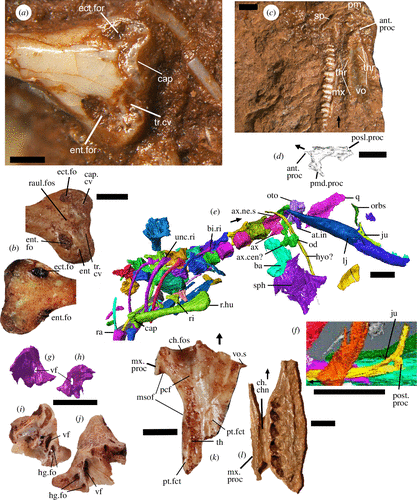@WFS,World Fossil Society, Athira, Riffin T Sajeev, Russel T Sajeev
Researchers have unearthed a giant basal tetrapod fossil in Namibia, revealing new aspects of early land animal evolution and highlighting the importance of southern continents in the study of these ancient species.
An international team of paleontologists has discovered a fossilized giant basal tetrapod in Namibia. Basal tetrapods, early four-legged vertebrates with fingers and toes, lived around 280 million years ago during the transition from aquatic to terrestrial life. These ancient carnivores are among the earliest ancestors of all modern animals. The nearly complete 3-meter-long skeleton, discovered in the Ugab River valley in Damaraland, belongs to a new species named Gaiasia jennyae.
This groundbreaking finding challenges the previous assumption that early tetrapods were only found in the northern hemisphere and offers new insights into the evolution of land-dwelling animals.
Unearthing a New Species
In their study, recently published in Nature, the team searched for evidence of the earliest four-legged animals to set foot on land in the ancient supercontinent Gondwana. Gondwana, which existed from about 550 to 180 million years ago, included what are now South America, Africa, Antarctica, Australia, and India.
While conducting fieldwork in Namibia, the researchers spotted something exciting. “The nearly complete skeleton was preserved in mudstone from an ancient freshwater lake. As the soft tissue decomposed, gases formed that caused calcium carbonate to crystallise around the bones, creating a hard crust that protected them from being crushed as they were buried deeper,” explains Prof. Roger Smith, Distinguished Professor at the Evolutionary Studies Institute at Wits and Emeritus Research Associate at Iziko Museums, Cape Town.
Sibusiso Mtungata, a highly skilled fossil technician from the Iziko Museum, describes the discovery moment: “We had found isolated vertebrae of something big, so we were looking for a more complete skeleton. I came across two round cylinders of rock with bone in the middle which fitted together – and then a third. I called Roger over to help me find more, and as we walked upslope, he spotted a large flat rock which he recognised as the head. When we looked along the edge and saw rows of teeth, we knew we had finally found what we had been searching for – a nearly complete skull and skeleton!”
The Significance of Gaiasia
Prof. Claudia Marsicano from the University of Buenos Aires, Argentina, elaborates on the significance of the find. “As soon as I saw this enormous animal, I knew it was a different species. There is no record of giant basal tetrapods during the Carboniferous-Permian transition (approximately 299 million years ago) anywhere in the world, and certainly none from the southern continents that made up Gondwana. What caught my attention next was the structure of the front part of the skull, which was sticking out of the ground. It showed unusually interlocking large fangs.” It was an ambush predator that ate the fish that lived in the same lake.
Collecting the fossil took some time. “The skeleton had already weathered out of the rock, so there was no need for excavation, but the whole team spent hours searching for fragments that had fallen off the skull block and moved downslope,” says Mtungata. The skeleton was then taken to the Iziko South African Museum in Cape Town to be painstakingly prepared in the Karoo Fossil Laboratory, a process that took two years. “Mechanical preparation was a challenge because it was too large to CT scan, so I didn’t know what to expect – especially in the palate where teeth of all different sizes were everywhere. And there was up to 10cm of rock around the vertebrae that needed to be drilled away, creating so much red dust that we had to bring in a special extractor,” Mtungata explains.
Analysis and Exhibition
The fossil preparation revealed that the large, flattened skull was decorated with unusual patterns and had a unique palate structure. It had enormous, backward-curved fangs in both the upper and lower jaws, making its mouth unlike anything seen before. Initially thought to be a large amphibian, further study showed that the skull had features of much older, less evolved four-legged animals, previously found only in older rocks in the northern hemisphere.
“We named the new species Gaiasia jennyae. ‘Gaiasia’ is after Gaias, a nearby desert spring where the fossil was found. ‘Jennyae’ honours Professor Jennifer Clack, a world-renowned expert in early tetrapod evolution, who passed away in 2020,” explains Smith.
The new findings strongly suggest that early tetrapods were well-established in the cold-temperate regions of Gondwana as early as the Carboniferous-Permian transition. “This discovery challenges previous beliefs about early tetrapod distribution and evolution, which were mostly based on fossils from the northern hemisphere,” says Marsicano. “Our research shows a well-established early Permian fauna, with Gaiasia as an apex predator, in rocks from high-latitude Gondwana, now located in central Namibia. This challenges previous ideas and proves that the early history of tetrapods in Pangea during the Palaeozoic was much more complex than we thought.”
The specimen has been returned to Windhoek, where it will soon be on display in the Geological Museum of Namibia.
Reference: “Giant stem tetrapod was apex predator in Gondwanan late Palaeozoic ice age” by Claudia A. Marsicano, Jason D. Pardo, Roger M. H. Smith, Adriana C. Mancuso, Leandro C. Gaetano and Helke Mocke, 3 July 2024, Nature.
DOI: 10.1038/s41586-024-07572-0
Source: Article by BY UNIVERSITY OF THE WITWATERSRAND@Scitechdaily.
@WFS,World Fossil Society, Athira, Riffin T Sajeev, Russel T Sajeev













 May 24th, 2025
May 24th, 2025  Riffin
Riffin 

















